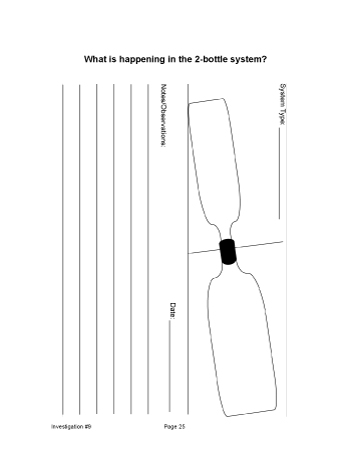Why do the water drops form?
Plan Investigation 9

The 2-bottle systems continue to change. The inside surfaces of the bottles are covered with water droplets and intriguing patterns and gradations in the drop sizes have developed. Why does it all happen as it does? The drops actually form a map of conditions inside the system, reflecting two variables: temperature and abundance of water vapor. In the coolest and most humid places, the drops have grown largest. No condensation forms in the warmest part of the system.
Formative Assessment
How do your students explain the process of condensation?
Available online at inquiryproject.terc.edu
How do your students explain the process of condensation?
Listen to their discussion of condensation inside the 2–bottle system to find evidence that students understand that water vapor is the source of water droplets formed during condensation.
Use these criteria to interpret students’ explanations. Do students explain that:
- Water vapor in the upper bottle is the source of the water droplets on the inside surface of the bottle?
- Condensation is the transformation of water vapor (invisible) to visible drops of liquid water on the inside of the bottle?
- Condensation occurs when water vapor comes in contact with a cool surface?
Make sure that everyone in the class understands the transformation of water vapor to water. The next step is to link this process to the process of evaporation.
Today's investigation is a continuation of the work students started in Investigation 8. Students check their home 2-bottle system. After describing what is happening, they rely on both observations and reasoning to again address the process: Why do water drops form on the inside of the bottles? The role of temperature is introduced, as well as the idea that the process of condensation is the opposite of evaporation. Finally, students measure and record the weight of their uncovered mini-lakes.
By the end of this session students will connect evaporation, water vapor, particles too small to see, and condensation. They will understand that the process of condensation is the reverse of the evaporation, and they will also start to understand that temperature has an influence on the process of condensation.
Learning Goals
- Understand that the process of evaporation involves particles of water too small to see breaking away from the surface of the water and becoming a gas.
- Understand that the process of condensation is the reverse of evaporation: water particles too small to see clump together to form visible drops.
- Understand that temperature difference is key to the process of condensation
| Sequence of experiences | ||
|---|---|---|
| 1. Ask the question | All Class | 5 Mins |
| 2. Explore | Small Groups | 5 Mins |
| 3. Share observations | All Class | 10 Mins |
| 4. Make meaning | Discussion | 15 Mins |
| 5. Weigh the mini-lakes* | Pairs | 10 Mins |
* If possible, have students weigh the mini-lakes before school starts, or during a lunch period, to have additional time during this investigation.
Materials and Preparation
For the class:
- Post the investigation question in a place where all students can see it.
- Dot Sheet 1 [pdf], Dot Sheet 2 [pdf], and Dot Sheet 3 [pdf] (See Resource Quick Links)
- 3 2-bottle systems
For each group:
- 1 digital scale
- 2 mini-lakes
- Freeze 2 trays of 1/2-inch mini ice cubes
The processes of evaporation and condensation inside the 2-bottle system
We do not suggest you present this information to your students. These ideas are presented here to help you understand some of the complexities of evaporation and condensation inside the closed, 2-bottle system.
- Condensation is related to both humidity and temperature difference. When air that includes water vapor is cooled to a lower temperature the particles of water vapor draw closer together. If the air is sufficiently cooled, drops of condensation will form. This is true even when that "cooled air" still seems warm, as it does inside the bottles. What matters is the temperature difference. Sufficient cooling of the humid air does not happen immediately below the lamp, but it does happen in most other parts of the system.
- Heat energy is necessary for evaporation to occur. Water can evaporate at very low temperatures, particularly when the humidity of the air is low. The heat from the lamp increases the rate of evaporation of water, but the lamp does not generate enough heat to evaporate anything else. However, even rocks would liquefy and then vaporize if the temperature were high enough.
- Net evaporation occurs when the rate of evaporation exceeds the rate of condensation. Inside the small 2-bottle closed system, humidity could quickly become high enough to stop net evaporation long before much water accumulates in the upper bottle. The added heat from the lamp forces net evaporation to continue even in a closed system with very high humidity.
Concept Cartoon

The Condensation Concept Cartoon is typically used as a formative assessment at the end of this investigation.






